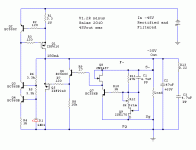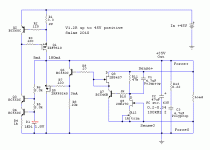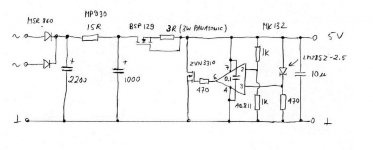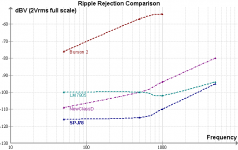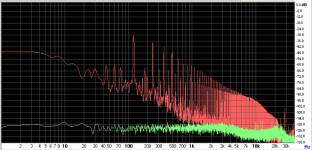Hi jackinnj,
How do you think about to compare also the Sallas regulator, you find this tread here:
http://www.diyaudio.com/forums/powe...listic-salas-low-voltage-shunt-regulator.html
Regards,
Rudy
It's an enormous thread with around 4,000 posts. I have printed out a couple of the schematics, but have to figger out which one is the definitive Salas!
Funnily enough I think if the regs output noise is not correlated with the load current, then it doesnt matter very much in and of itself.so I guess at some point even the most critical audiophile is happy with the remaining noise floor?
To me that, means achieving that means very low output Z over a wide bandwidth is highly desirable, but after filtering out incoming crud and being 'reasonably' quiet over a nice wide bandwidth - there's no need to go mad on noise. Focus on regulation.
OK -- here's the PSRR test of several regulators mentioned -- the Belleson is consistent, but hardly outstanding.
I used a Jensen 600:600 ohm transformer -- very flat from a few Hz to 200kHz -- it's the model AP uses in their PSRR test. The injected voltage was 1V RMS.
What I find most interesting about those PSRR plots is that the Belleson's is, as you observed, consistent. None of the usual PSRR degradation with increasing frequency, well, at least not within the test bandwidth.
Hi jackinnj,
This is the final definitive schematic of the Salas regulator.
I hope this is the right one, I ask in the other thread the schematic and I get this one.
Regards,
Rudy
This is the final definitive schematic of the Salas regulator.
I hope this is the right one, I ask in the other thread the schematic and I get this one.
Regards,
Rudy
Attachments
Last edited:
Maybe this one is also interesting Peter Daniel use this one in the Shigaclone and his DAC.
http://www.diyaudio.com/forums/digi...ransport-shigaclone-story-92.html#post2519723
Regards,
Rudy
http://www.diyaudio.com/forums/digi...ransport-shigaclone-story-92.html#post2519723
Regards,
Rudy
Attachments
BMW850 said:Maybe this one is also interesting Peter Daniel use this one in the Shigaclone and his DAC.
Good topology, bad implementation.
Hi jackinnj,
This is the final definitive schematic of the Salas regulator.
I hope this is the right one, I ask in the other thread the schematic and I get this one.
Regards,
Rudy
Some of the earlier ones I simmed -- I get very good numbers.
Some of the earlier ones I simmed -- I get very good numbers.
Hello jackinnj,
How are the measurements at the moment now.
Have you done comparisons with the other regulators, which regulator have the best papers ?
Regards,
Rudy
Hello jackinnj,
How are the measurements at the moment now.
Have you done comparisons with the other regulators, which regulator have the best papers ?
Regards,
Rudy
Nothing to report.
Hi all,
These are beautiful words but this is all true what it says on the site of Belleson?
Now we have no longer to look at other brands, or is this all marketing strategy ... or are they real good what it say on the site!
Superpower Super Regulator by Belleson
The Belleson Superpower, the ultimate voltage regulator
· Superpower compared to a Battery
· Superpower compared to a Jung style super regulator
· Superpower compared to LM317
· Superpower compared to LM7812
· Superpower compared to Dexa NewClassD
· Superpower compared to Burson
The Belleson Superpower regulator, like Mr. Jung's design, uses the regulator's cleaned and quieted output voltage as the "bootstrapped" power source for its own internal reference and error amplifier. In addition,
· It is stable with the included 10µF output capacitance and remains stable with larger values.
· Output voltage is set with a single resistor.
· Superpower fits a 3 terminal regulator footprint and can bolt directly to a heat sink.
· Start-up is guaranteed—the expected output voltage is the only stable state.
· Gain/bandwidth of the internal amplifier is independent of output voltage.
· Drop-out voltage is as low as ½V at low current, less than 2V at currents to ½A for standard or 1A+ for the HV and J versions.
· Superpower performs better without a pre-regulator.
· There are no zener diodes.
Regards,
Rudy
Hi Rudy,
Thanks for your interest in Belleson Superpower, I recently was made aware of this thread and will be responding to various posts as time permits.
I designed the regulator and my name is on the patent application. If the patent office moved faster I could perhaps give you a schematic but we're not ready for that yet. So we can discuss performance but I suspect most DIY readers are mostly interested in a schematic.
I can tell you there is no magic, no fairy dust and no snake oil. We spent 2 years in R&D on this device, including extensive characterization, before publishing the specifications. It's not a perfect regulator but is better all around than anything else we've tested, and we continue to make improvements and enhancements.
Regards,
Brian
I'm not convinced that this regulator is so wonderful. Its noise is specified at 28uVrms, higher than the LM317 value of 22uVrms and far higher than, say, a TeddyReg.
In the transient comparison with the LM317, no mention is made of the exact LM317 feedback configuration ("as in datasheet" could mean anything). And for the 1A transient a larger-than-standard output device is used! How about we just put multiple LM317s in parallel?
Overall, I anyhow think that the LM317 is very hard to beat, especially considering the price. I can get one from my local electronic parts shop around the corner for 1.25 Euros. For the money of a Belleson, you can put a lot of those in cascade and in parallel!
--
Greetz,
MatchASM
Hi MatchASM,
Yes, noise is not as low as TeddyReg, which has a line of praise on our web site for this performance. However, in our analysis TeddyReg does not regulate very well, given it's DC shift with output current. It also has thermal dependencies and, I suspect, fairly high Zout due to its open loop design. Low noise is important, but it's not the only important spec.
The LM317 was tested with Cin=0.1uF, Cref=10uF, Cout=1uF, R1=270 Ohms, R2=2K Ohms, Vin=30V, Vout=10.8V. An 8 Ohm load was switched from Vout to ground using a D880-Y power NPN. The SPJ Superpower uses a standard D44H11 or D45H11 output transistor.
If you are planning to use regulators in parallel, I suggest the LT3080 or something similar, not LM317.
Regards,
Brian
Belleson, LLC
There's too much missing from any of the comparisons, and the datasheet, to form any real opinion.
Martin,
What additional information would you like?
Regards,
Brian
Belleson, LLC
It's unfortunate that Belleson doesn't feel comfortable enough to provide at least a simplified schematic so that potential buyers can better assess the novelty of their regulator design.
Ken,
With only 9 components in the basic design, the schematic is already simplified
Brian
Belleson, LLC
OK -- here's the PSRR test of several regulators mentioned -- the Belleson is consistent, but hardly outstanding.
I used a Jensen 600:600 ohm transformer -- very flat from a few Hz to 200kHz -- it's the model AP uses in their PSRR test. The injected voltage was 1V RMS.
Hi jackinnj,
Our measurements for PSRR are quite different from yours, see the graph. These measurements were taken with 1Vpp not RMS, and only to 5KHz.
Also see the spectrum comparison of a rectifier signal into a Superpower and the regulated output. This shows the nasty spectrum of the semi-sawtooth out of a full wave rectifier (red) and the clean signal (green) from the regulator. Measurements are referred to 0dB=2Vrms. The rolloff above 20K is due to a filter in the spectrum analyzer.
Given the large range of bad performance from several regulators, I suspect you are measuring something other than the regulator. At these levels of voltage it's easy to get poor measured results. It's easy for a measurement to be worse than actual performance and more difficult to make something measure better than it is. The most time consuming task we have when designing tests is to isolate the measurement system errors from the DUT errors. For example, we had PSRR problems with a particular type of test socket feeding through from input to output.
You don't say how your transformer test circuit is connected, is it possible that DC current is saturating the core and skewing the measurements? This could cause errors that depend on regulator current consumption.
We use an active driven source to feed the input rather than a transformer, and are working on a PSRR test circuit that uses an LM3886 to drive the input with DC+AC.
If you are interested, we can pick a couple of monolithic 3 terminal regulators to pass back and forth in the mail until we agree on a correlated measurement or until we tire of the exercise
Regards,
Brian
Belleson, LLC
Attachments
What I find most interesting about those PSRR plots is that the Belleson's is, as you observed, consistent. None of the usual PSRR degradation with increasing frequency, well, at least not within the test bandwidth.
Ken,
I suspect some other effect is being measured in the plots, not the Superpower under test. Or perhaps the device is damaged.
Brian
Belleson, LLC
If the patent office moved faster I could perhaps give you a schematic but we're not ready for that yet.
I'm curious, how long has the application been in? I've had them take up to 3 years in the past to get a patent ruling. I wonder if they are better or worse now.
I'm curious, how long has the application been in? I've had them take up to 3 years in the past to get a patent ruling. I wonder if they are better or worse now.
It will be 2 years in June and I've yet to be contacted by an examiner. What are your patents?
It will be 2 years in June and I've yet to be contacted by an examiner. What are your patents?
That particular application which took 3 years was on an internet-related device 16 years ago - and was ultimately rejected.. We also heard nothing the entire time, despite multiple tries by our patent lawyer to get an update.
- Status
- This old topic is closed. If you want to reopen this topic, contact a moderator using the "Report Post" button.
- Home
- Amplifiers
- Power Supplies
- The Belleson Superpower, the ultimate voltage regulator ... ?
